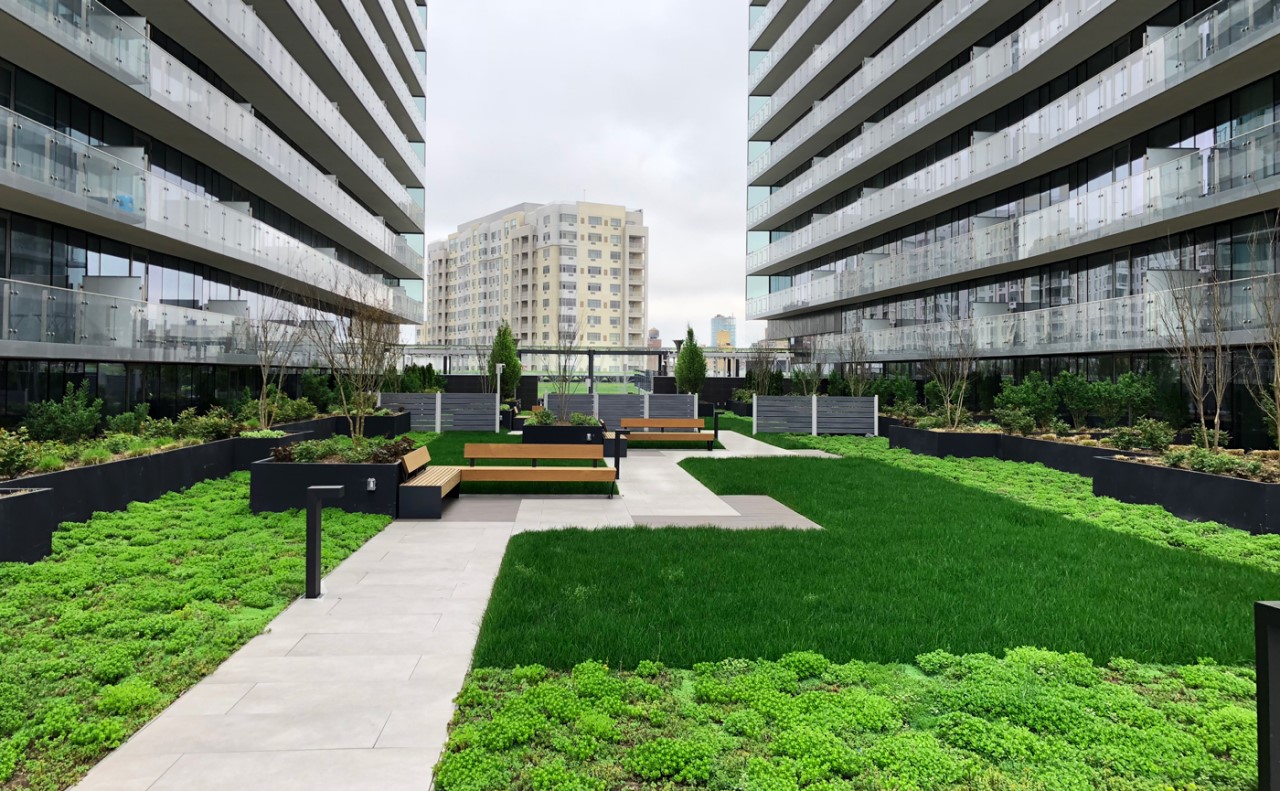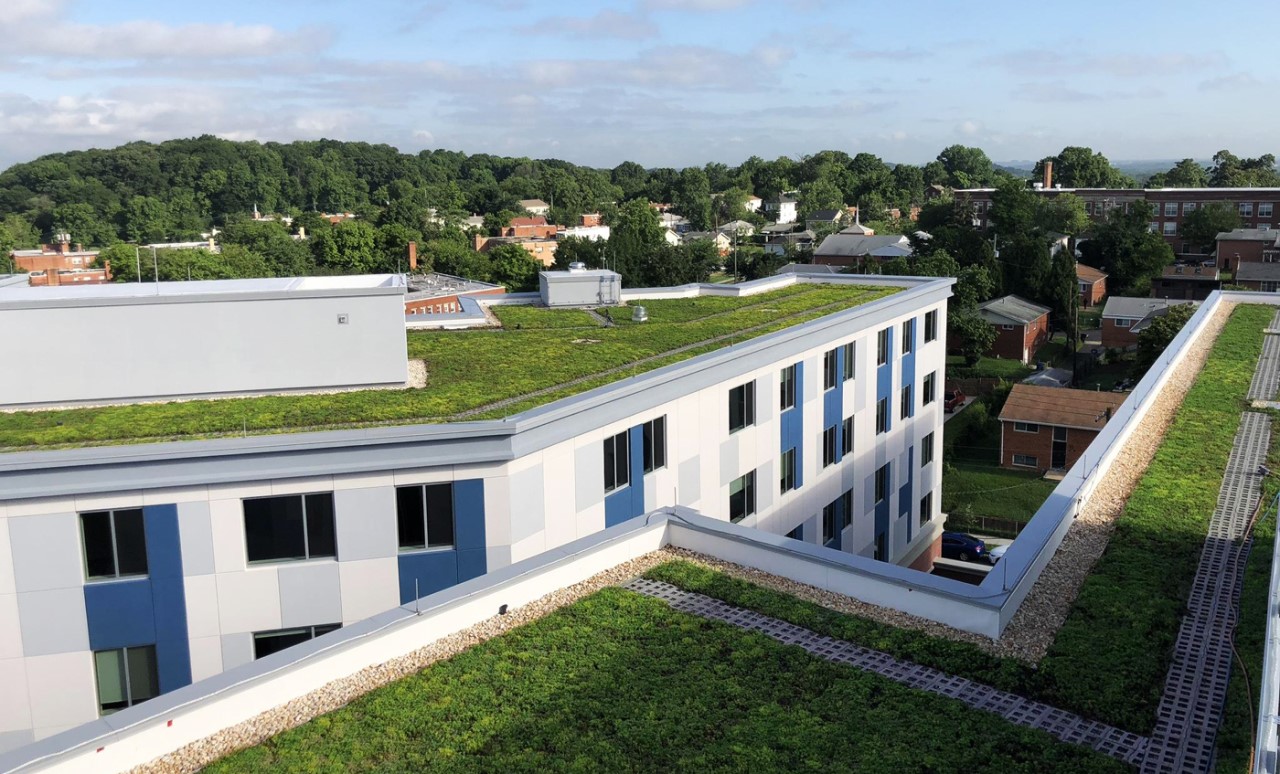Purple-Roof approved stormwater management tool New York City
Posted on Tuesday 15 November, 2022Following other big cities in the United States, the New York City Department of Environmental Protection (DEP) has approved the Purple-Roof® concept as a valid stormwater capture and management tool. This means that developers and building owners now have a cost-effective and space saving tool at their disposal to manage stormwater according to NYC regulations.
Important precedent
The NYC DEP has tested the Purple-Roof concept intensively to ensure its performance. Matt Draus, Green Roof Specialty Products, Sempergreen USA:
“The NYC DEP (Department of Environmental Protection) stormwater requirements are some of the most stringent in the US, and the Purple-Roof concept was highly scrutinized in theory and in practice. They required samples and testing data for each material, examples of past installations and owner testimony of its performance prior to approval.
With the DEP approval completed, most other (smaller) US municipalities will see that as a stamp of approval from a very large entity with the resources to thoroughly review the new concept and ensure its performance. That DEP scrutiny will greatly reduce any hesitation by other regulators when adopting/approving the new system.”
The Purple-Roof concept
But what is a Purple-Roof and how does it differ from a green roof? Just like a green roof, a Purple-Roof is covered with a vegetation layer, but it’s able to detain a greater amount of rainwater during heavy rainstorms. In short, it is a living roof system in which rainwater falling on the roof is temporarily collected and delayed from leaving the building through the sewer system. With a normal roof, without vegetation, precipitation immediately enters the sewer system through the downspout, which can result in flooding of the sewers and, subsequently, the streets, during heavy downpours. A Purple-Roof is able to store rainwater even in a fully saturated state and drain it in a controlled manner.
Two birds with one stone
An important benefit of the Purple-Roof concept, is the fact that it is a living roof. Local New York City, laws 92 and 94 require the installation of either a solar PV, a green roof, or a combination of the two, on all new construction buildings. This also applies to buildings undergoing major renovations, meaning those which require a building permit. This means, that with a Purple-Roof you can catch two birds with one stone, adhering to two both the green roof and the storm water regulations at once.
Read more about other sustainable city plans in the world
The perfect solution to your building challenges
This has also other benefits. The Purple-Roof concept will function on most flat and low-sloped roofs and is best suited for projects that have limited space, that may have a green roof already specified on the project, or that have other design challenges. A landscaped bed or a retention pond are typically less expensive than a Purple-Roof. However, some site conditions (and most in large cities) may not allow for traditional ponds or tanks. Existing underground utilities, a high ground-water table, existing bedrock, sloping grades, or high real estate costs are a few factors that may make a large retention pond or concrete storage tank impractical, or even impossible. In these cases, managing stormwater on the roof with the Purple-Roof concept may be the perfect solution.

Relaxation and effective stormwater management on one roof
Increased revenue and cost savings
Last, but certainly not least, are the financial benefits the installation of a Purple-Roof can provide. If your building has a stormwater management tool on the roof, the space that would have otherwise been occupied by a water tank or pond can instead be used for parking, retail space, or residential units, for example. Some projects may see a significant reduction in construction costs, because some regular storm water management solutions are more expensive than a Purple-Roof, especially if a green roof has already been included in the design.
To see how this works, have a look at these two Purple-Roof case studies in Washington DC.
7 New York Avenue, Washington DC
The project team of 7 New York Avenue had an interesting engineering puzzle to solve; how to best manage stormwater at their new site while maximizing every square foot of the constrained, triangular-shaped lot. The 14-story, 115-unit project in Noma, Washington DC, is a model of efficient use of space. It includes 66 “microunits” (410 sf), 12 “urban one-bedrooms” (519 sf), 26 one-bedrooms (506 sf). The 11 remaining units are one-bedrooms with dens. Space is at such a premium that the development does not include any vehicular parking.
Designed by Eric Colbert & Associates and constructed by Donohoe Construction with Henry and Gordon Contractors Inc, the luxury building includes a rooftop amenity space with a green roof and is pursuing LEED certification. The building covers nearly the entire lot, and with the strict DC Stormwater Regulations in effect, their stormwater storage and outflow reduction requirements were substantial. The default option was to use a traditional detention tank system. That would include engineering, excavation, hauling, concrete foundations, a pump system and plumbing and electrical systems. That system would also require extremely valuable square footage.
The 2nd option was to simply upgrade the traditional green roof to a Purple-Roof system. This upgrade added Needled Mineral Wool, primarily for Retention and filtration and a Detention Layer to provide the required detention and stormwater outflow reduction (85%). Upgrading to a Purple-Roof and eliminating the tank allowed for greater design flexibility and unit density, which directly converted into ROI for the Owner.
Tank System and loss of 1 micro unit = $525,000
Purple-Roof upgrade cost of $55,000
Cost Saving- $470,000
4910 Georgia Avenue, Washington DC
The 4910 Georgia Avenue development in Washington, DC is a 5-story residential building that originally included traditional green roofs of 6” and 8” depths in its design. Those profiles specified did not provide the required retention, detention and peak outflow reduction needed to completely manage the stormwater, therefore the owners were also required to include permeable paving.
During review, it was determined that by upgrading the green roofs to Purple-Roof concept vegetated roofs, the owners could install standard paving at grade instead of permeable, saving $43,811.83 in construction costs.
More information for your project
Would you like to see more cases studies like this? Or do you have any other questions? Please don’t hesitate to contact us!
You can also find more information on https://www.purple-roof.com/.

This roof merges beautifully with its green background
